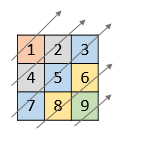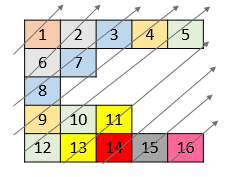难度: Medium
给你一个列表 nums ,里面每一个元素都是一个整数列表。请你依照下面各图的规则,按顺序返回 nums 中对角线上的整数。
示例 1:

输入:nums = [[1,2,3],[4,5,6],[7,8,9]] 输出:[1,4,2,7,5,3,8,6,9]
示例 2:

输入:nums = [[1,2,3,4,5],[6,7],[8],[9,10,11],[12,13,14,15,16]] 输出:[1,6,2,8,7,3,9,4,12,10,5,13,11,14,15,16]
示例 3:
输入:nums = [[1,2,3],[4],[5,6,7],[8],[9,10,11]] 输出:[1,4,2,5,3,8,6,9,7,10,11]
示例 4:
输入:nums = [[1,2,3,4,5,6]] 输出:[1,2,3,4,5,6]
提示:
1 <= nums.length <= 10^51 <= nums[i].length <= 10^51 <= nums[i][j] <= 10^9nums中最多有10^5个数字。